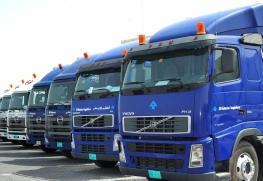
Covers
all
aspects
of:
Transport
Planning,
Load
Planning,
Weighbridge
Integration,
Despatch,
Remote
Warehouses, Third Party Warehouses, and Documentation.
Transport
Planning
uses
live
information
from
your
Sales
and
Production
Systems
to
determine
orders
to
be
despatched,
and
in
what
sequence.
The
system
identifies
orders
that
are
ready,
and
those
planned
to
be
ready
by
any
specified
date.
This
is
used
for
both
the
ordering
of
vehicles
and
the
planning
of
despatches.
The
Transport
Plan
details
the
specific
requirements
of
each
load.
It
can
specify
exactly
which
Rolls
or
Pallets
are
to
be
loaded,
by
unique
identity
and
location.
Alternatively,
the
number
of
items
(or tonnage) of a product can be specified, rather than individual items.
Upon
arrival
at
site,
vehicles
are
issued
with
a
Transport
Reference,
which
summarises
here
to
collect
the
load
and
what
is
to
be
loaded.
The
tare
weight
of
the
vehicle
can
also
be
recorded.
The
Transport
Reference
will
subsequently
be
handed
to
the
Despatch
operator
for
cross-checking
at
the
point
of
Despatch.
The
details
of
the
required
load
are
displayed
by
entering
the
unique
TRN
into
the
system.
The
system generates predefined picking lists (either paper or electronic) and carries out on-line verification.
As
verified
items
are
loaded
onto
the
vehicle,
the
system
monitors
the
increasing
weight
to
avoid
overloading.
Once
completed,
the
Despatch
Note
is
printed
and
a
copy
passed
to
the
driver.
Despatch
Note
stationery
can
be
configured
to
your
own
specification,
or
can
be
a
standard
design.
Once
the
vehicle
has
successfully
crossed
the
Weighbridge,
the
Despatch
Note
will
be
fixed
and
the
items
on
the
Despatch Note identified as ready for invoicing.
For
UK
operators,
HMRC
reporting
can
be
generated
in
terms
of
Intrastat
and
EU
Sales
analysis
and
the
system
generates
fully
compliant
datasets
according
to
HMRC
submission
requirements.
Handles
shipping by road, rail or sea. Container details, Bills of Lading, etc. can all be accommodated.
The
system
also
includes
a
Transport
Self
Billing
module,
which
can
be
used
to
calculate
costs
associated
with
the
shipping
of
goods
from
one
location
to
another.
Rates
are
determined
by
geographical
location
using
a
rate
matrix
and
haulier
invoices
are
generated
to
either
validate
transport
company
invoices
or
to
generate the purchase accruals to manage haulier costs more effectively.
ascman : logistics
© ascman ltd 2025
“Specialist IT solutions for roll-based, cores and flat sheet industries”

Transport Planning
Load Planning
Marshalling / Picking
Load Verification
Weighbridge Integration
Documentation


Covers
all
aspects
of:
Transport
Planning,
Load
Planning,
Weighbridge
Integration,
Despatch,
Remote
Warehouses,
Third
Party
Warehouses,
and
Documentation.
Transport
Planning
uses
live
information
from
your
Sales
and
Production
Systems
to
determine
orders
to
be
despatched,
and
in
what
sequence.
The
system
identifies
orders
that
are
ready,
and
those
planned
to
be
ready
by
any
specified
date.
This
is
used
for
both
the
ordering
of
vehicles
and
the
planning
of
despatches.
The
Transport
Plan
details
the
specific
requirements
of
each
load.
It
can
specify
exactly
which
Rolls
or
Pallets
are
to
be
loaded,
by
unique
identity
and
location.
Alternatively,
the
number
of
items
(or
tonnage)
of
a
product can be specified, rather than individual items.
Upon
arrival
at
site,
vehicles
are
issued
with
a
Transport
Reference,
which
summarises
here
to
collect
the
load
and
what
is
to
be
loaded.
The
tare
weight
of
the
vehicle
can
also
be
recorded.
The
Transport
Reference
will
subsequently
be
handed
to
the
Despatch
operator
for
cross-checking
at
the
point
of
Despatch.
The
details
of
the
required
load
are
displayed
by
entering
the
unique
TRN
into
the
system.
The
system
generates
predefined
picking
lists
(either
paper
or
electronic)
and
carries
out
on-line verification.
As
verified
items
are
loaded
onto
the
vehicle,
the
system
monitors
the
increasing
weight
to
avoid
overloading.
Once
completed,
the
Despatch
Note
is
printed
and
a
copy
passed
to
the
driver.
Despatch
Note
stationery
can
be
configured
to
your
own
specification,
or
can
be
a
standard
design.
Once
the
vehicle
has
successfully
crossed
the
Weighbridge,
the
Despatch
Note
will
be
fixed
and
the
items
on
the
Despatch
Note
identified as ready for invoicing.
For
UK
operators,
HMRC
reporting
can
be
generated
in
terms
of
Intrastat
and
EU
Sales
analysis
and
the
system
generates
fully
compliant
datasets
according
to
HMRC
submission
requirements.
Handles
shipping
by
road,
rail
or
sea.
Container
details,
Bills
of
Lading,
etc.
can all be accommodated.
The
system
also
includes
a
Transport
Self
Billing
module,
which
can
be
used
to
calculate
costs
associated
with
the
shipping
of
goods
from
one
location
to
another.
Rates
are
determined
by
geographical
location
using
a
rate
matrix
and
haulier
invoices
are
generated
to
either
validate
transport
company
invoices
or
to
generate
the
purchase
accruals
to
manage
haulier
costs more effectively.
ascman : logistics
© ascman ltd 2025
“Specialist IT solutions for roll-based,
cores and flat sheet industries”

Transport Planning
Load Planning
Marshalling / Picking
Load Verification
Weighbridge
Integration
Documentation




















